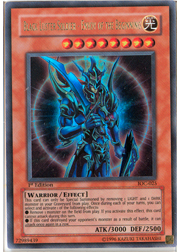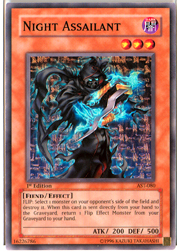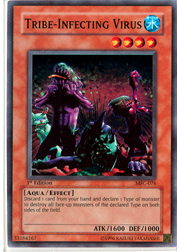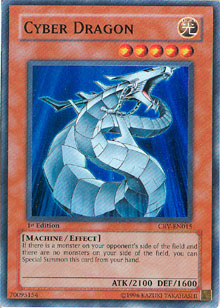By now, you’ve probably seen the new Forbidden and Limited list for the Advanced format. In days, these lists will change how the game is played—necessitating new decks, new strategies, and new tech. If you haven’t seen it yet, check out the new Forbidden and Limited lists here before reading.
While many will debate various points of the list, it seems difficult to refute the fact that its general impact will be positive. Today we’ll take a look at just that—the broad effects on gameplay that the new Advanced format will have. This isn’t an article about what decks will dominate the format, as Metagame.com will get to that later. Let’s examine the actual changes that will occur to the play environment.
The Fall of Chaos and Goat Control
 Black Luster Soldier – Envoy of the Beginning has been forbidden, and the theory that Chaos Emperor Dragon – Envoy of the End might replace it through rotation back into the current format has been laid to waste. The next best thing is Chaos Sorcerer, and while I’m sure some players will try to build decks around it, Chaos Sorcerer is a far more balanced card than Black Luster Soldier or Chaos Emperor Dragon ever were. There’s no reason to play cookie-cutter Light/Dark decks any more.
Black Luster Soldier – Envoy of the Beginning has been forbidden, and the theory that Chaos Emperor Dragon – Envoy of the End might replace it through rotation back into the current format has been laid to waste. The next best thing is Chaos Sorcerer, and while I’m sure some players will try to build decks around it, Chaos Sorcerer is a far more balanced card than Black Luster Soldier or Chaos Emperor Dragon ever were. There’s no reason to play cookie-cutter Light/Dark decks any more.
At the same time, Thousand-Eyes Restrict, Metamorphosis, Scapegoat, Book of Moon, and Tsukuyomi have all been limited to one copy per deck. Though most Goat Control players were only running a single Tsukuyomi anyway, and its limitation seems more like reinforcement for that of Book of Moon, the deck needs two copies of Metamorphosis and three copies of Scapegoat to work. The limiting of these two cards deals a fatal blow to the Goat Control strategy, and the limit placed upon Thousand-Eyes Restrict is just a kick in the ribs after the fact.
Rejoice, for these decks are gone.
You’ll rarely see your hard-earned Jinzo inhaled by an ill-gotten Thousand-Eyes Restrict ever again. You’ll never watch your opponent lock down the game for turns on end with sheep token after sheep token after sheep token. And you’ll probably never wince sharply at the words, “I’ll remove a Light and a Dark . . . ”
It’s over. It had its ups and downs, but the era of Chaos is over. The new age of Yu-Gi-Oh! will require far more skill and ingenuity, and it will be less reliant on overpowered cards that are subject to luck.
No More Trinity
 Speaking of luck, the “trinity” of Pot of Greed, Graceful Charity, and Delinquent Duo are also gone. While Japan lost only Graceful Charity and Delinquent Duo, it was decided that for North America’s play environment, “balance” was the word of the day, and Pot of Greed is gone as well.
Speaking of luck, the “trinity” of Pot of Greed, Graceful Charity, and Delinquent Duo are also gone. While Japan lost only Graceful Charity and Delinquent Duo, it was decided that for North America’s play environment, “balance” was the word of the day, and Pot of Greed is gone as well.
We’ll all miss topdecking it when we’re down and out—but I’m sure we won’t miss being beaten by it in games we should have won.
The problem with the trinity cards, though multi-tiered, can be summed up in one point: they gave too much power for no skill or investment. Everyone played with them, and there was virtually no way to support them in your deck by investing anything beyond the deck slots that the three spells required. It all came down to luck of the draw. If your opponent drew a trinity card or two and you did not, you were in trouble. It didn’t matter if you were playing against someone who knew how to play well or not—he or she would drop the card and claim its powerful effect, and the duel would become that much more difficult for you. Thrilling? Sure! But this really didn’t make for a balanced play experience, nor did it reward players who had put in the time to develop the skills that are unique to the game.
Now that period is over. The days of easy card advantage are gone, and the main source of card advantage will likely be the battlefield. Want to gain that +1 advantage that you so desperately want? You’re probably going to have to take it out of a monster’s hide.
In the long run, this will probably translate to a higher presence of self-replacing monsters in tournaments. But it will also result in big monsters seeing a lot more play, and ratios of 20 monsters to 20 spells and traps will probably become the norm again. I’ve seen a lot of people crack open a Cybernetic Revolution booster and sigh as they pull a Goblin Elite Attack Force. Sigh no more, as that puppy’s stock is going to rise quite a bit over the next few months.
Also of note on this topic is the limiting of Magician of Faith. The Magician has been robbed of its three favorite toys, and while there are plenty of spells that are great when they’re used twice, spell recursion will now be a matter of skill and choice. It will also become far more difficult to reuse Magician of Faith over and over. Though Magical Hats can turn it face down, it now relies on only a single Book of Moon and one Tsukuyomi. Magician of Faith is still good, but it’s no longer a staple for virtually all the competitive decks in the format. Losing your ability to create multiple cards’ worth of disparity between your hand count and your opponent’s hand count does that.
Night Assailant and Sinister Serpent Gone
 While we’re on the topic of hand advantage, Night Assailant and Sinister Serpent are now gone, and that again eliminates one of the more common methods of out-drawing your opponent. Okay, okay, so Night Assailant is still here—but that’s kind of the problem, isn’t it? It’s a singular statement, as it’s been limited to one per deck. Sure, it can recycle Magician of Faith, Magical Merchant, or Slate Warrior, but you can’t activate Card Destruction, discard a pair of Assailants, and then take them back to gain yourself a quick card’s worth of advantage and a new hand, can you?
While we’re on the topic of hand advantage, Night Assailant and Sinister Serpent are now gone, and that again eliminates one of the more common methods of out-drawing your opponent. Okay, okay, so Night Assailant is still here—but that’s kind of the problem, isn’t it? It’s a singular statement, as it’s been limited to one per deck. Sure, it can recycle Magician of Faith, Magical Merchant, or Slate Warrior, but you can’t activate Card Destruction, discard a pair of Assailants, and then take them back to gain yourself a quick card’s worth of advantage and a new hand, can you?
In short, the card now works as it was intended to. I loved Sinister Serpent, but it had to go in order for the new list to accomplish some of its goals. Only one Nobleman of Crossout? Sinister Serpent would have made Tribute to the Doomed and Phoenix Wing Wind Blast into obvious replacements. Without an easy way to circumvent the cost systems the designers attached to certain cards in the game, those cards work as they were intended to work.
Truth be told, I’ve been riding both Sinister Serpent and Night Assailant for ages. To me, a pair of Night Assailants and a single Card Destruction were auto-inclusions for any deck that I was building. Sinister Serpent was already an undisputed staple of the format—very few people refused to run it, and poor Sangan was reduced from a skill-testing card of choice and consequence to being nothing more than the Serpent’s delivery boy. Sangan is still going to be a staple for most strategies, but it’ll no longer go on auto-pilot by running off to your deck to find its serpentine pal the moment it’s destroyed.
“I feel so free!” the little fuzzball exclaimed in a recent interview. We feel free too, Sangan.
Themed Strategies Flourish
 I barely even minded when a new player would play Pot of Greed on me and then draw right into Delinquent Duo. Whatever. Good luck, right? It happens to the best of us. But what really got under my skin was when I'd clearly be winning a game, I’d trapped my opponent by playing cleverly and rendering the cards in his or her hand dead, and then he or she would topdeck Tribe-Infecting Virus. My opponent would then blow away my entire field for a discard or two, attacking to win the game a couple of turns later, and steam would blow out of my ears and from other, more cheeky places.
I barely even minded when a new player would play Pot of Greed on me and then draw right into Delinquent Duo. Whatever. Good luck, right? It happens to the best of us. But what really got under my skin was when I'd clearly be winning a game, I’d trapped my opponent by playing cleverly and rendering the cards in his or her hand dead, and then he or she would topdeck Tribe-Infecting Virus. My opponent would then blow away my entire field for a discard or two, attacking to win the game a couple of turns later, and steam would blow out of my ears and from other, more cheeky places.
Heaven forbid if I were playing a deck that carried a monster type theme. Warrior Rush? My horde of sword-wielding weenies would be gone for the cost of a single spell that should have probably been a dead piece of hand presence. Machines? Cannon Soldiers and Mechanicalchasers would all fall in unison, and even Reflect Bounder’s mighty effect, designed specifically to keep it on the field, would be rendered completely null and void.
I’d go back to my teched-out Chaos build, just like a child beaten off the baseball diamond by consecutive strike-outs goes running home to mommy. And while I’d find wins in my accursed near–cookie-cutter deck, there’d be no solace in its Light and Dark arms. Only shame—the hideous shame of relinquishing a dream.
Maybe that’s a bit melodramatic, but you get the gist. Having an awesome themed deck that just can’t manage to make it through an entire tournament due to Tribe-Infecting Virus was, for lack of a technical term, sucky. Well, now we get the last laugh, because Tribe-Infecting Virus has been locked away for a very long time!
Break out those Warrior decks. Power on those Machines. Water? Sure, give Giga Gagagigo and his pals some fresh air. Fire decks are pretty underrated too. Get creative, get ambitious, and get into your binders and shoeboxes. Resurrect those ideas that came close to winning in the previous format but had to be shelved because theme decks were just too tough to play. Now they’ll be the standard. Bye-bye Tribe-Infecting Virus, hello innovation.
Pace of Play
Go ahead. Set that monster. Try and bluff me. I know it isn’t Mirror Force or Ring of Destruction, and you’ll have far fewer sheep tokens to duck behind.
That’s right, I’m talking to you, the conservative duelist. The era of hiding behind a wall of wool and obfuscation is over, and we’re back to the good old days. Monsters will clash in grand battle on a turn-by-turn basis, and mutton is no longer on the menu. Yu-Gi-Oh! used to be a blazingly fast game, and it will be again under the new Advanced format lists.
Because so much card advantage will hang in the balance of battle, combat itself will be more frequent. Bigger and bigger monsters will see play, and exchange-based play styles will likely come back to the forefront of dueling strategy. (Exchange-based play styles are where players keep dropping monsters and smacking each other down until one player gets overpowered and the other controls the field.)
 Several cards will encourage this shift. You can expect three copies of Cyber Dragon to be common in a large number of decks. They’ll literally be everywhere. While Cyber Dragon is a no-brainer for Machine decks, it adds massive speed to Warrior decks while at the same time giving a cheap piece of field presence to hold off Warriors themselves. It’s big, it’s free, and it’s unpredictable, and those three factors make it a truly gamebreaking card in the new format. Some players won’t run it, but it’s really a matter of personal style. Many players will, and if you aren’t ready for Cyber Dragon, you probably won’t win many tournaments.
Several cards will encourage this shift. You can expect three copies of Cyber Dragon to be common in a large number of decks. They’ll literally be everywhere. While Cyber Dragon is a no-brainer for Machine decks, it adds massive speed to Warrior decks while at the same time giving a cheap piece of field presence to hold off Warriors themselves. It’s big, it’s free, and it’s unpredictable, and those three factors make it a truly gamebreaking card in the new format. Some players won’t run it, but it’s really a matter of personal style. Many players will, and if you aren’t ready for Cyber Dragon, you probably won’t win many tournaments.
The removal of semi-limitation from Marauding Captain will also speed up the general pace of play. Expect Warriors to be a strong choice in the new format, and the special summoning of Cyber Dragon, followed by Marauding Captain and then a third monster, will be a feared play on turn 2. Yes, it opens you up to Dark Hole. But it can also result in 5000 damage or more, and that’s just too good to be ignored.
Big monsters plus less recourse against aggression means we’ll be in for faster games. Get aggressive, or prepare to watch your defense position monsters get picked off one by one. There’s no more trinity and no more Black Luster Soldier – Envoy of the Beginning to wait for. Only combo decks will turtle into their shells and await victory.
Of Powerhouses and Presence
All the new additions to the Forbidden and Limited lists total up to some serious deck space being available outside of the obvious picks. One of the biggest ways these slots will be used is for increased monster removal. Sakuretsu Armor, Bottomless Trap Hole, and Smashing Ground are going to be seeing a lot more play, and for a good reason. Though each is just a one-for-one trade and thus will not grant card advantage unless it’s used against a tribute monster, the actual resource of field presence will be worth the investment.
That’s right: “the resource of field presence.” Think about that concept—though it’s simple, it will be highly important in the coming months. That single normal summon per turn is going to be something precious and will need to be managed very carefully. Expect My Body as a Shield to see play to achieve this end, while Cursed Seal of the Forbidden Spell will be useful for repelling the multiple copies of Smashing Ground that so many duelists will be using.
We’re about to enter a new era of speed, creativity, and (most importantly) fun in the Yu-Gi-Oh! TCG. Build those decks you felt would never quite be viable. Dust off those monsters from sets gone by—the ones relegated to your binder for not fitting the cookie cutter mold. The possibilities are boundless, and you, the player, get to reap the rewards.
In short, welcome to the new dawn of Yu-Gi-Oh! It’s going to be one heck of a ride!
—Jason Grabher-Meyer
Do you have any thoughts on these changes? To what extent will they improve the game? Email entertainment@upperdeck.com and let your voice be heard!